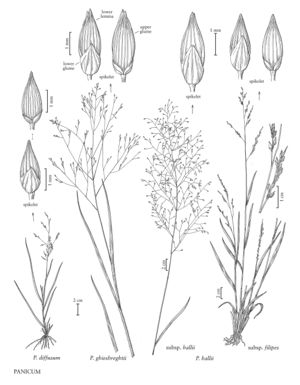Panicum diffusum
Plants perennial; cespitose and shortly rhizomatous. Culms (6) 25-100 cm, 0.5-3.5 mm thick, spreading to weakly ascending, usually freely branching; nodes pilose, hairs spreading to ascending; internodes pilose, with papillose-based hairs, or sparsely hispid. Sheaths rounded, glabrous, margins shortly ciliate distally; ligules 0.6-4 mm, of hairs; blades (3) 6-15 cm long, 1-5 mm wide, spreading, abaxial surfaces sparsely hirsute, adaxial surfaces more densely so, hairs papillose-based, midribs prominent and not white, margins involute, bases cuneate, apices subulate. Terminal panicles 3-35 cm long, about 1/2 as wide, shortly exserted; axillary panicles smaller, not fully exserted; rachises scabridulous; primary branches usually solitary, sometimes paired, divergent and widely spaced, secondary branching mostly on the distal 1/3 of the primary branches; pedicels 1-4 mm, spreading to appressed, confined to the distal portions of the secondary branches. Spikelets 2.1-2.9 mm long, 0.8-1 mm wide, glabrous. Lower glumes 1-1.2 mm, to 1/2 as long as the spikelets, attenuate, 5-9-veined, veins anastomosing apically; upper glumes and lower lemmas similar, extending about 0.5 mm beyond the upper florets, 11-13-veined; lower florets sterile; lower paleas 1-1.3 mm; upper florets 1.5-1.8 mm long, 0.6-0.8 mm wide, smooth. 2n = 36.
Distribution
Puerto Rico, Virgin Islands, Tex., La.
Discussion
Panicum diffusum grows along river banks, ditches, and disturbed areas in wet, loamy or clayey soils. Its range extends from Texas to the Caribbean and northern South America.
Selected References
None.
Lower Taxa
"decumbent" is not a number."-11-veined" is not declared as a valid unit of measurement for this property.
